Vajrakilaya: put a peg in it ! — Cutting the three poisons with the sharpest weapon: destroying ignorance, greed, and hostility with profound Vajrakumara
Vajrakilaya is the most “cutting” of wrathful meditational deities — a wrathful Heruka (‘hero’) emanation of glorious Vajrasattva. At the same time, he is the ultimate expression of Bodhichitta and compassion and love. He is the Heruka of activity...
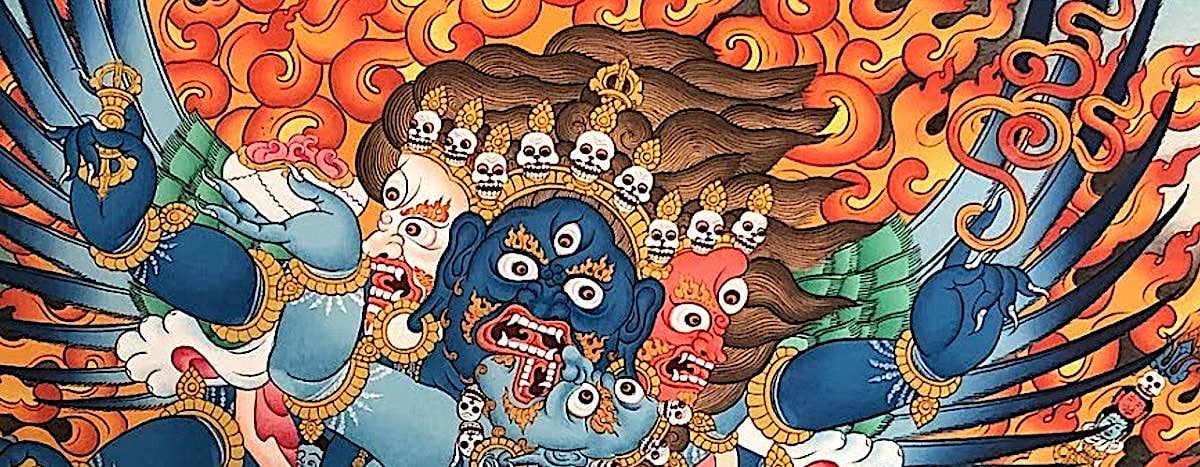
Vajrakilaya is the most “cutting” of wrathful meditational deities — a wrathful Heruka (‘hero’) emanation of glorious Vajrasattva. At the same time, he is the ultimate expression of Bodhichitta and compassion and love. He is the Heruka of activity and represents the Enlightened activity of ALL of the Buddhas. This aspect of the Buddha is the “sharp weapon” against the big three enemies, the “demons” of craving and greed, hate and hostility, and ignorance and misapprehension.
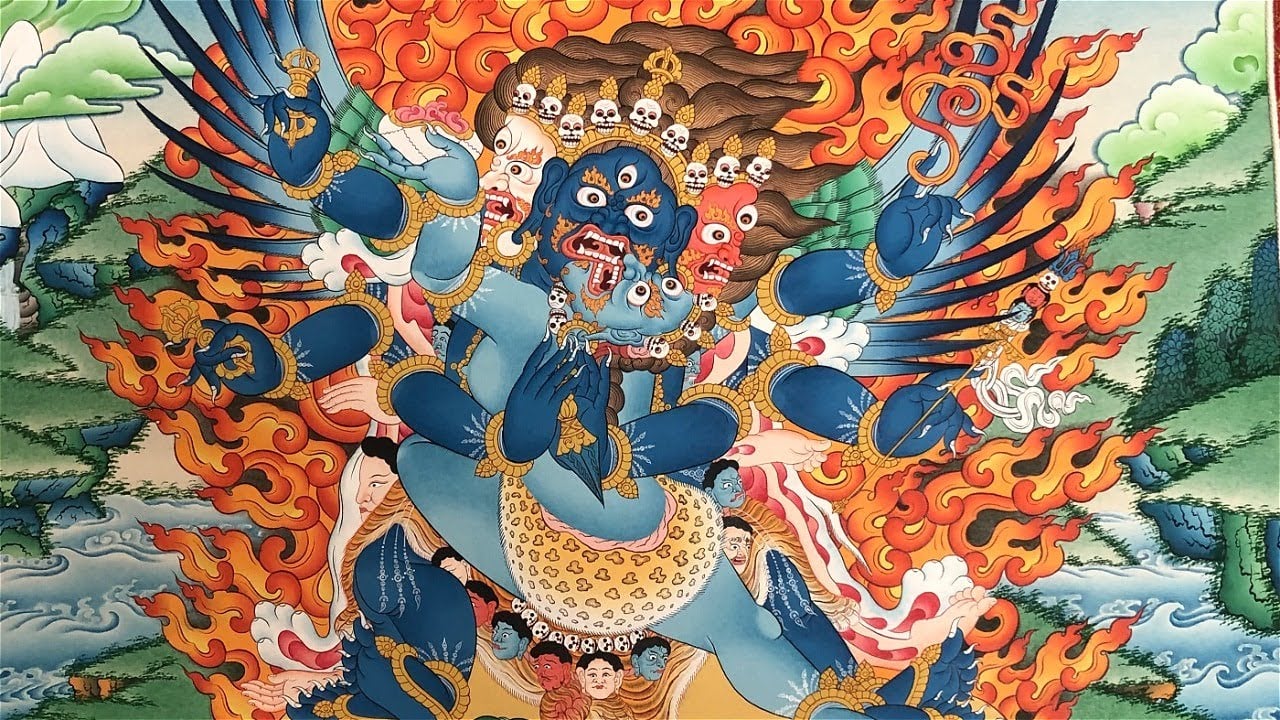 Vajrakilaya, close-up, in his wrathful form with three faces blue, white and red, clasping the iconic Phurba (Kila) peg or knife that cuts all three poisons — a very profound and powerful visualization. He has the wings of a Heruka — as one of the eight great Herukas, the wrathful aspects of the Buddhas.
Vajrakilaya, close-up, in his wrathful form with three faces blue, white and red, clasping the iconic Phurba (Kila) peg or knife that cuts all three poisons — a very profound and powerful visualization. He has the wings of a Heruka — as one of the eight great Herukas, the wrathful aspects of the Buddhas.
Vajrakilaya’s practice is particularly efficacious in overcoming obstacles and cutting through negative mental states and conceptual thinking. Vajrakilaya is also known as “Vajrakumara” or “Diamond Son”. He is the most wrathful and powerful form of the obstacle-remover Vajrasattva, with Vajrapani as his Bodhisattva form (the Bodhisattva of Power) and Vajrakilaya as the supreme “angry” form. He was one of the chief Yidams of the great and glorious Guru Rinpoche Padmasambhava — and it was through this practice that he attained realizations.
A Vajrakilaya Drupchen performed by monks from Ugyen Phuntshog Choeling Nyingmapa Monastery:
At the same time, ferociousness notwithstanding, he is a fully Enlightened Buddha, with unlimited love, compassion, and Bodhichitta. Kyabje Garchen Rinpoche explains [3]:
“In this regard, in the Vajrakīla literature, there is a very meaningful prayer of blessing that says, “All the buddhas regard beings with a mind of great love.” When its meaning has been understood, each word of this line has the power and ability to calm one’s mind. The deity’s heart essence is love and affection. The very nature of his or her past pledge to sentient ones is loving-kindness. Each time one gives rise to it—even if one is only focused on a tiny insect—it becomes a cause for accomplishing the supreme siddhi. When one repeatedly cultivates an actual feeling of love and affection, that itself is the deity’s mind. That is the accomplishment of the yidam. On this basis, immeasurable great love can arise. This essential point must be understood.”
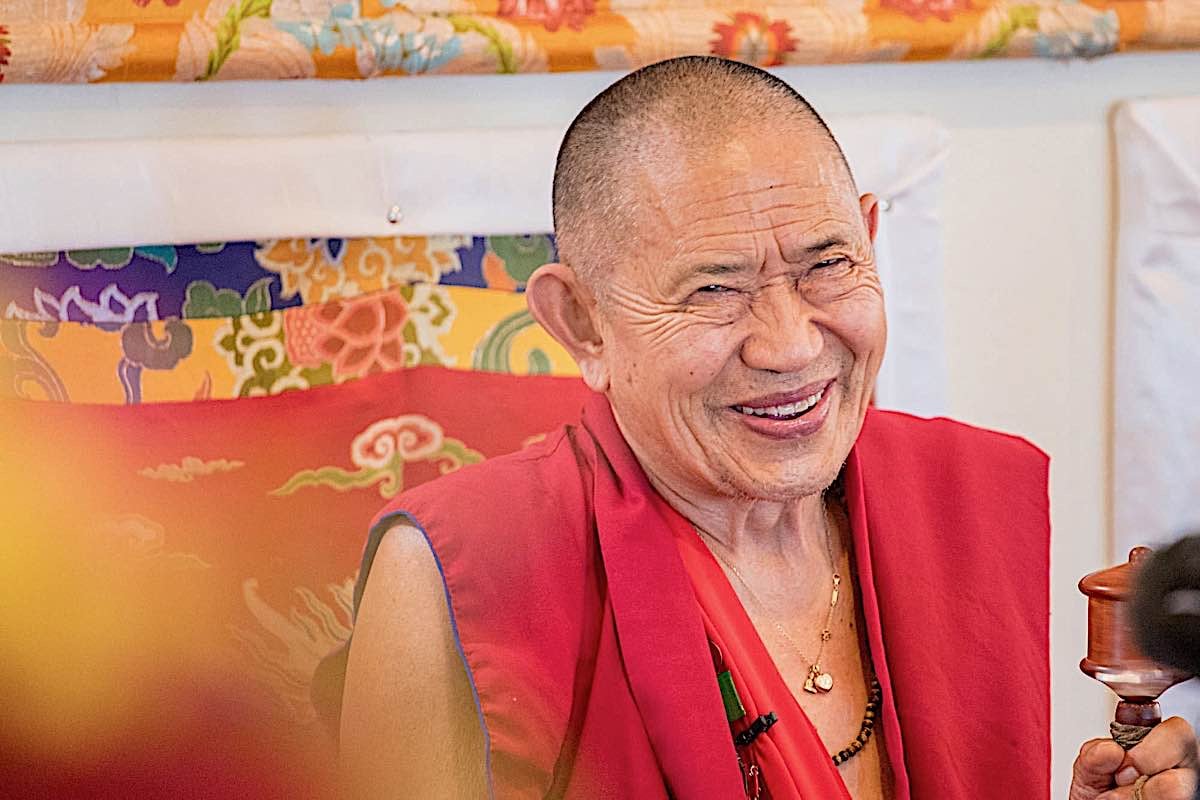 Kyabje Garchen Rinpoche from a teaching session on Vajrakilaya. This venerable and kind teacher wrote a 2022 book on Vajrakilaya (see notes) — which is highly profound, in-depth, and relatable for modern students.
Kyabje Garchen Rinpoche from a teaching session on Vajrakilaya. This venerable and kind teacher wrote a 2022 book on Vajrakilaya (see notes) — which is highly profound, in-depth, and relatable for modern students.
The sharp weapon of anger
The wrath or anger, in the case of all Herukas — and especially here with the most wrathful of all the Herukas, Vajrakilaya — is directed powerfully at the three poisons in service of all sentient beings.) It is, as Kyabje Garchen Rinpoche explained, a force of love.
The metaphorical concept is that power and focused wrath is required to overcome the terrible grasping poisons of greed, hostility, and ignorance. In most cases, rational, peaceful contemplative methods tend to fail against the irresistible forces of these attachments and desires in Samsara, at least in the short term (and certainly in our modern age full of temptations and greed.) Forceful “enlightened activity” can more quickly overcome these forces.
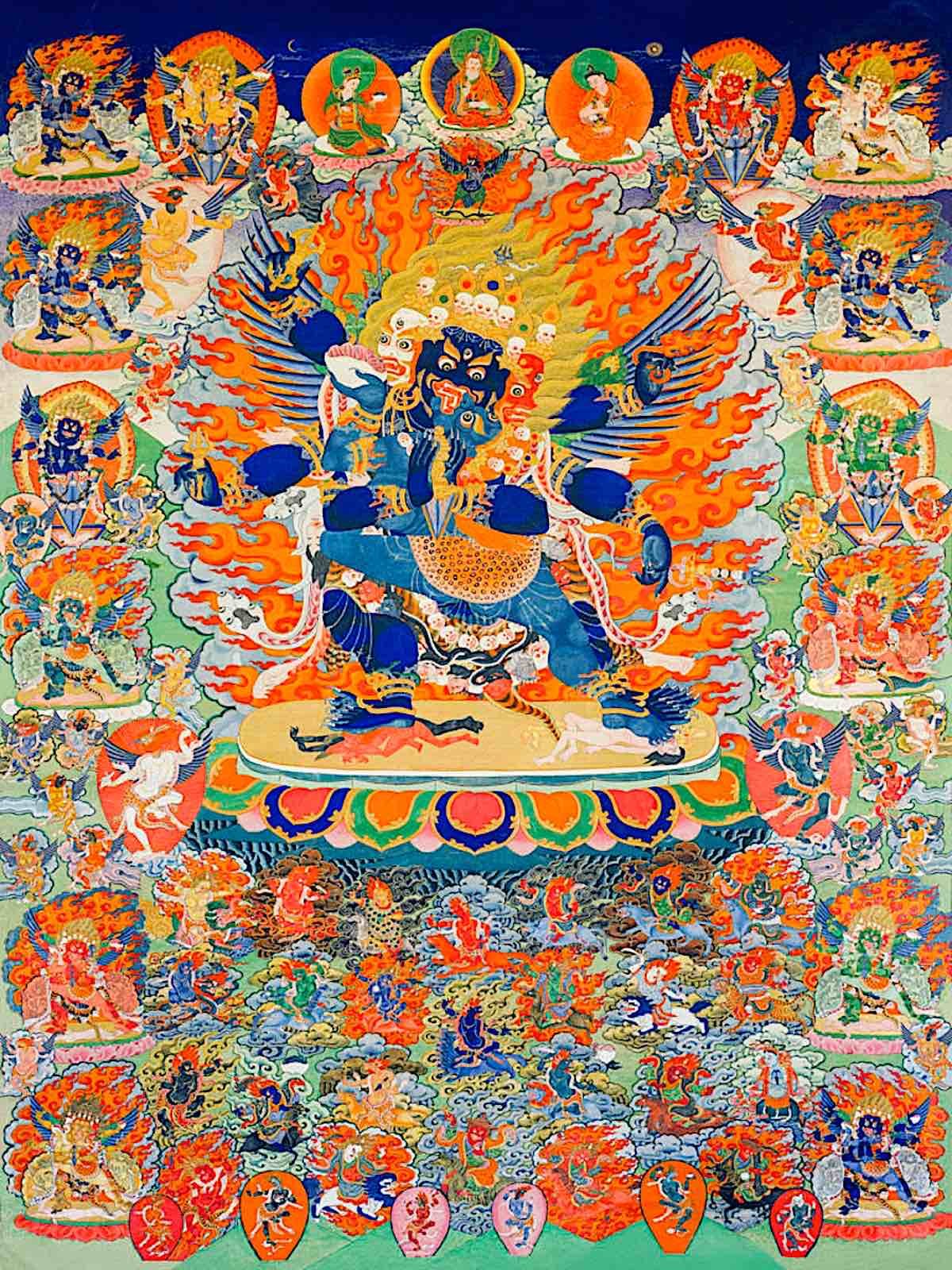 This is the typical form of Vajrakilaya, with six arms, three faces and consort, with Heruka wings.
This is the typical form of Vajrakilaya, with six arms, three faces and consort, with Heruka wings.
The sharpest and most forceful of these “enlightened activity forces” is Vajrakilaya (Skt. Vajrakīlaya; Tib. རྡོ་རྗེ་ཕུར་པ་, Dorje Phurba, Wyl. rdo rje phur pa) or Vajrakumara (Skt. Vajrakumāra; Tib. རྡོ་རྗེ་གཞོན་ནུ་, Dorje Shönnu; Wyl. rdo rje gzhon nu).
A single thrust with his three-pointed Phurba (Kila) cuts all the illusions, hatred, and grasping.
Kyabje Garchen Rinpoche briefly introduces Vajrakilaya practice and describes his new book:
His other attributes also “visually inform” the meditator of his powers to overcome the delusions: Heruka wings, wisdom flames, three faces — blue representing enlightened mind, red representing enlightened speech, and white representing the enlightened body of the Buddha — six arms representing the six paramitas, with feet stomping on the demons of obstacles to our realizations. (How powerful is that!) Yet, most iconic is the Kila (Phurba) — the sharp weapon that cuts all the demons of anger (hate), delusion (ignorance) and attachment (greed.)
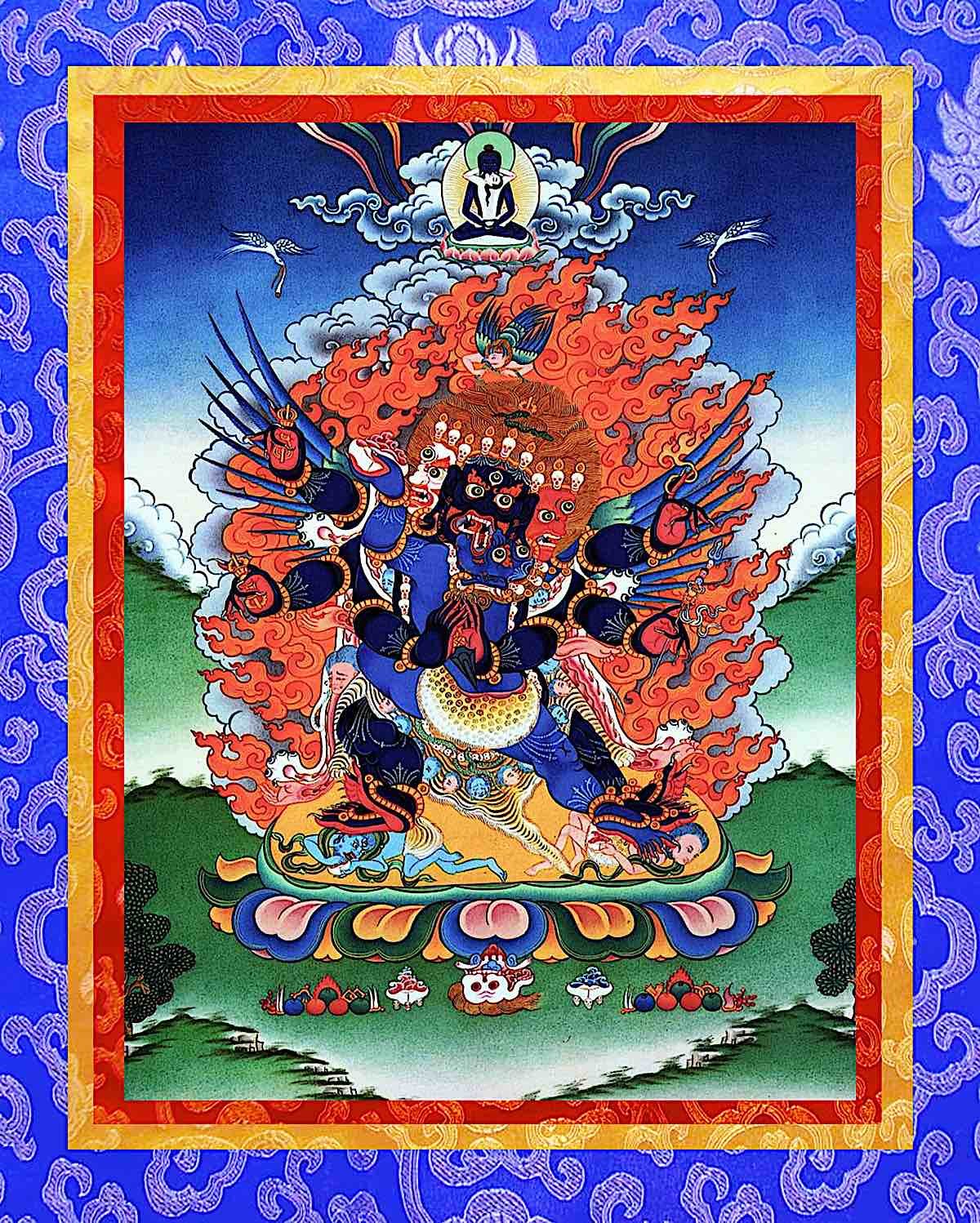 Vajrakilaya or Vajrakumara, who represents the activity of all the Buddhas. He has Heruka wings six arms, four legs, consort, and implements. In his front two hands is a Phurba — his powerful three-sided blade which cuts the three poisons of anger, delusion, and jealousy. They stand on the demons of our attachments, to demonstrate suppression. They also stand on nagas (representing diseases and other defilements. Behind them are the wisdom flames. Over the head is a Garuda, the sacred bird of the Northern Purelands.
Vajrakilaya or Vajrakumara, who represents the activity of all the Buddhas. He has Heruka wings six arms, four legs, consort, and implements. In his front two hands is a Phurba — his powerful three-sided blade which cuts the three poisons of anger, delusion, and jealousy. They stand on the demons of our attachments, to demonstrate suppression. They also stand on nagas (representing diseases and other defilements. Behind them are the wisdom flames. Over the head is a Garuda, the sacred bird of the Northern Purelands. Why Vajrakilaya versus another Yidam?
Only you, your own particular afflictions, and your teacher’s guidance will be the guide in choosing a particular Yidam (only one is generally recommended) — but chances are, in these difficult, modern times, a Yidam like Vajrakilaya can be most powerful and useful.
Ultimately, all Yidams are expressions of one Buddha mind, body, speech. The attainments are the same — only the methods vary. Kyabje Garchen Rinpoche explains this in his amazing practice manual on Vajrakilaya [4]:
“Whichever deity one practices, his or her power derives exclusively from bodhicitta. So it is with the deity Vajrakīla. If one practices this yidam from among all the other yidams, one can attain buddhahood in a single lifetime. Those who wish to accomplish this deity must give rise to the mind set on supreme enlightenment and must sustain it until the rank of manifest, complete buddhahood has been attained.”
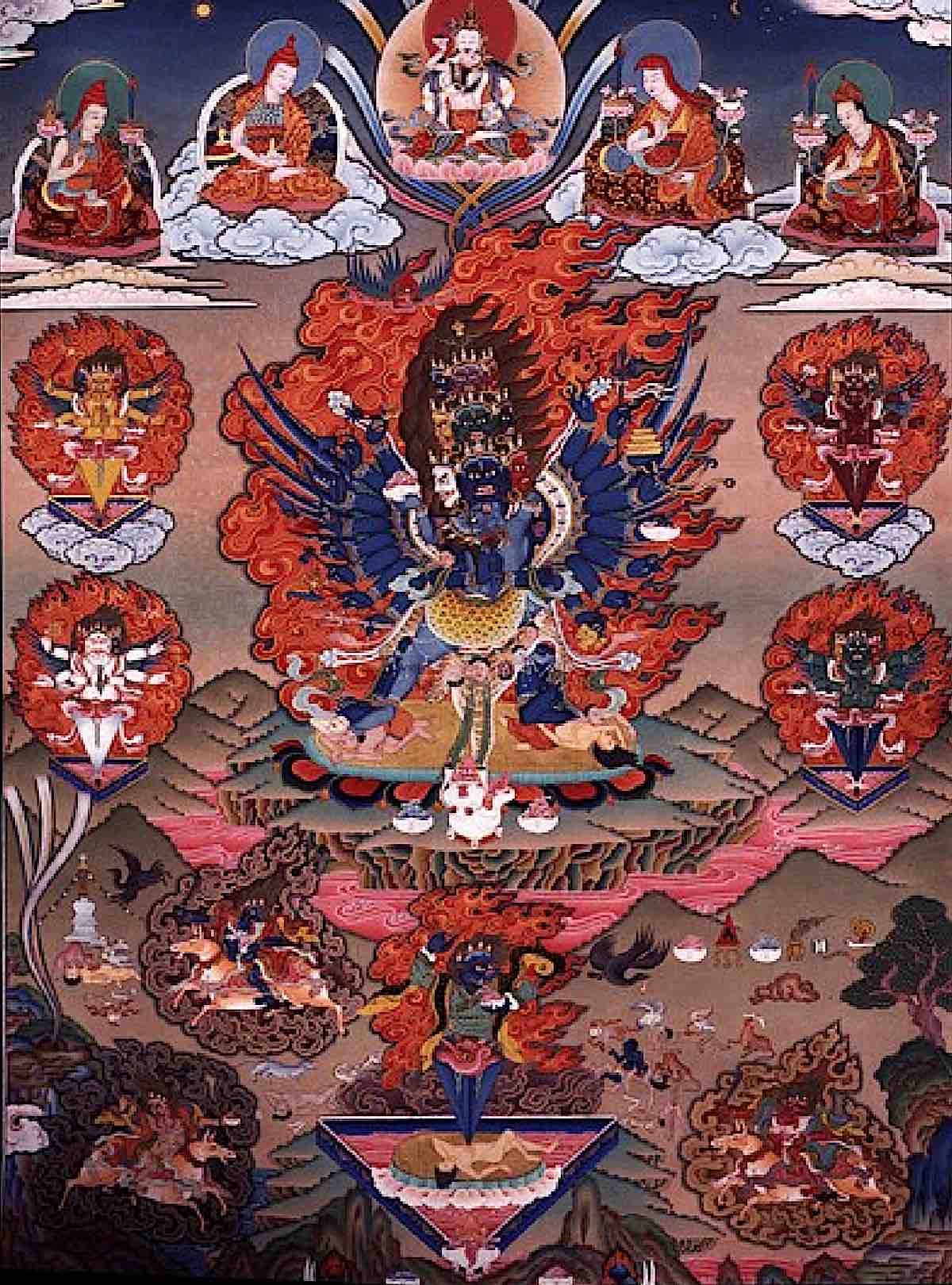 In this detailed mandala Thangka of Vajrakilaya of the Eight Pronouncements, he is surrounded left and right and in front with five activity Kilas (Phurbas). On his right (our left) is the yellow Kila (Phurba) deity representing increasing activities, below him is the white Kila (Phurba) representing pacifying activities. To his left (our right) are red on top representing power or magnetizing activities, and below him is the blue Phurba for wrathful activity.
In this detailed mandala Thangka of Vajrakilaya of the Eight Pronouncements, he is surrounded left and right and in front with five activity Kilas (Phurbas). On his right (our left) is the yellow Kila (Phurba) deity representing increasing activities, below him is the white Kila (Phurba) representing pacifying activities. To his left (our right) are red on top representing power or magnetizing activities, and below him is the blue Phurba for wrathful activity.One reason for Vajrakilaya’s popularity is he represents the activity of all the Buddhas: peace, power, wrath, and prosperity.
Another reason is many miracles are associated with his practice in the early histories of Buddhism. Kyabje Garchen Rinpoche describes one of many [10]:
“Yeshe Tsogyal attained the common and supreme siddhis and became the principal transmitter of the Vajrakīla tantras and sadhanas. Her liberation story documents numerous miracles attributed to her, such as reviving the corpse of a young man and having a spring emerge from the spot where she had thrust her kīla (phurba) into stone.”
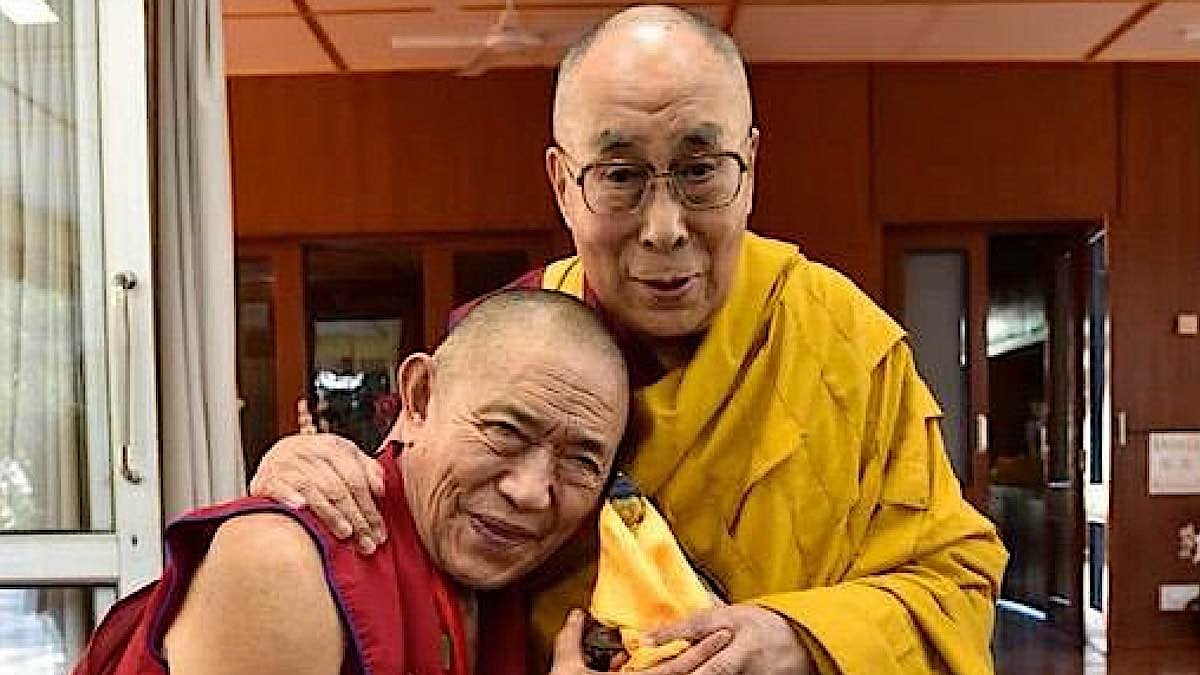 His Holiness the Dalai Lama hugs Kyabje Garchen Rinpoche. His Holiness the Dalak Lama received empowerment in Vajrakilaya and completed the retreat. Kyabje Garchen Rinpoche is a major teacher of Vajrakialaya, among other Yidams.
His Holiness the Dalai Lama hugs Kyabje Garchen Rinpoche. His Holiness the Dalak Lama received empowerment in Vajrakilaya and completed the retreat. Kyabje Garchen Rinpoche is a major teacher of Vajrakialaya, among other Yidams.
Who teaches and practices Vajrakilaya?
His Holiness the Dalai Lama received empowerment and completed a retreat in Vajrakilaya and considers it an important practice. The Dalai Lama explained [8]:
“I received the Vajrakilaya empowerment for the first time from Dilgo Khyentse Rinpoche and subsequently undertook the retreat.”
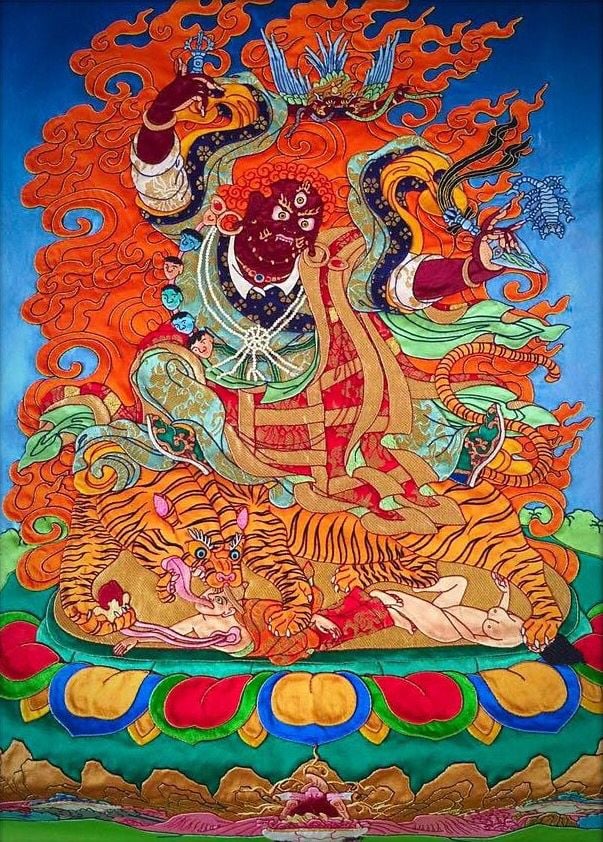 Dorje Drolo, is one of the most wrathful of Padmasambavha’s eight manifestations. In his left hand (our right) is a Phurba, in his left hand a Vajra.
Dorje Drolo, is one of the most wrathful of Padmasambavha’s eight manifestations. In his left hand (our right) is a Phurba, in his left hand a Vajra.
Historically, the most famous teacher of Vajrakilaya in Tibet was the great and glorious Buddha Guru Rinpoche Padmasambhava. Kyabje Garchen Rinpoche explains [9]:
“It is said that when Guru Rinpoche left India for Tibet, two men were needed to bear the load of the palm-leaf volumes of Vajrakīla literature alone. Those writings came to symbolize Guru Rinpoche’s subjugation of all obstructive forces. The Vajrakīla literature is like the wish-granting tree, as it allows one to accomplish the common and supreme—whatever one could desire. Guru Rinpoche himself arranged in Tibetan language each of the Vajrakīla sections of tantra—thirty-six different subdivisions in all.”
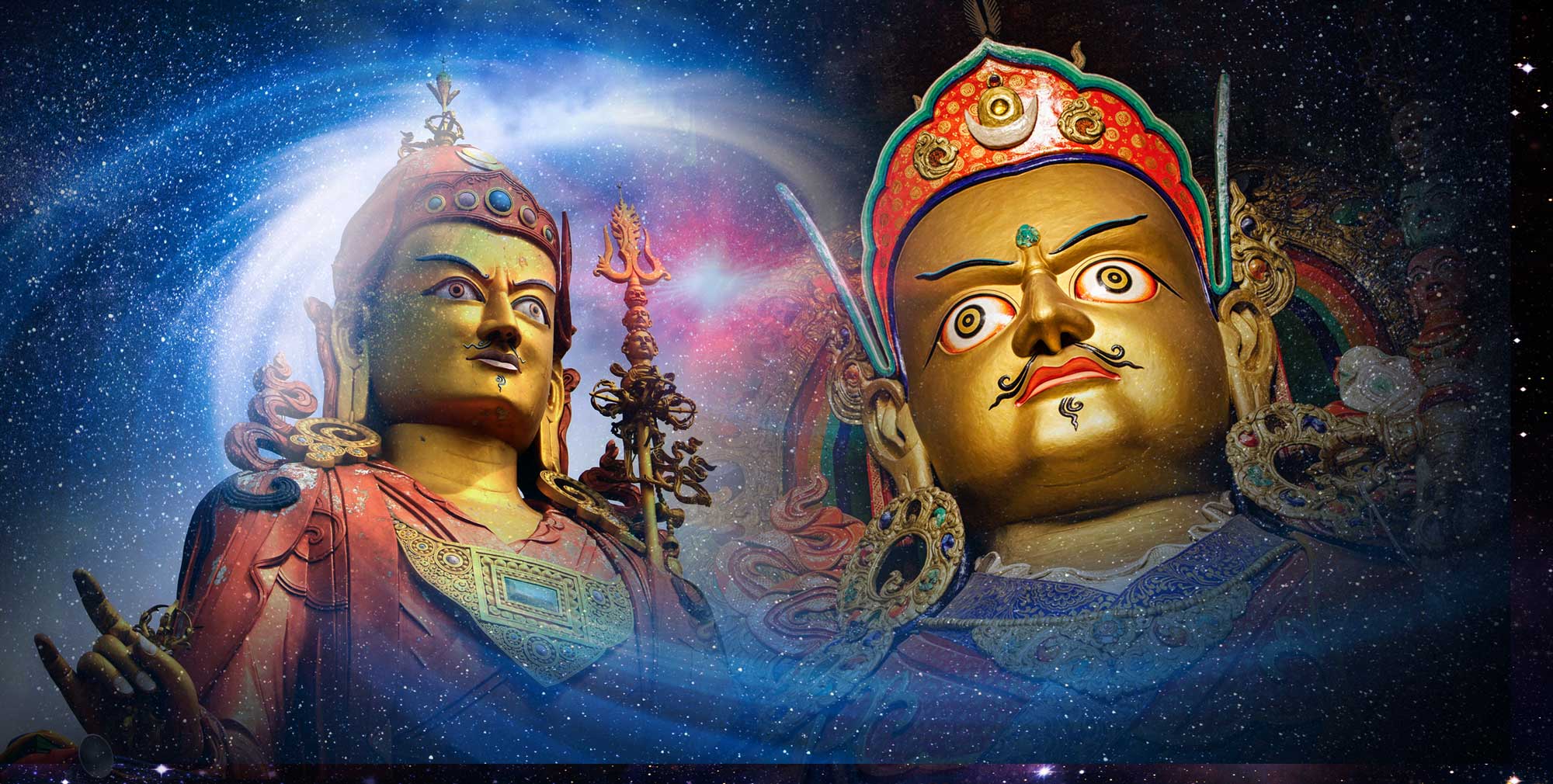 Guru Rinpoche.
Guru Rinpoche.
Robert Beer, in his amazing book on Buddhist symbols [1] writes:
“In the biography of Padmasambhava, it is recorded that he travelled to the northern land of Kashakamala, where the cult of the kīla prevailed. Later, whilst meditating on the deity Yangdak Heruka (Skt. Vishuddha Heruka) in the ‘Asura Cave’ at Parping in the Kathmandu valley, he experienced many obstructions from the maras, and in order to subjugate them he request the Kīla Vitotama Tantras to be brought from India. Having established the first Tibetan monastery at Samye, the first transmission that Padmasambhava gave to his 25 ‘heart disciples’, in order to eliminate the hindrances to the propagation of the buddhadharma in Tibet, were the teachings of the Vajrakilaya Tantra. From its early Nyingma origins the practice of Vajrakilaya as a yidam deity with the power to cut through any obstructions was absorbed into all schools of Tibetan Buddhism.”
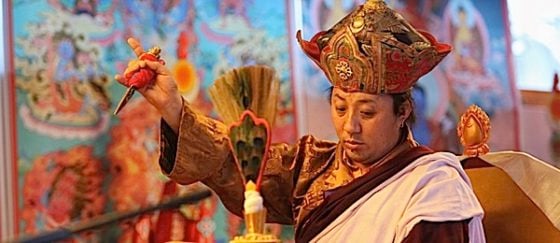 Namkha Rinpoche with a Phurba. Namkha Rinpoche is Rigdzin Pema Tuthob’s root guru.
Namkha Rinpoche with a Phurba. Namkha Rinpoche is Rigdzin Pema Tuthob’s root guru.Most lineages have Vajrakilaya as a practice, and as a significant Heruka. It is typical higher yoga practice. Notable teachers of the Kagyu, Nyingma and Sakya traditions offer Vajrakilaya as a main Yidam practice choice. His Holiness the Dalai Lama of the Gelugpa tradition often recommends and encourages the practice of Vajrakilaya. Kyabje Garchen Rinpoche often offers teachings and recommends Vajrakilaya practice in these modern, stressful times.
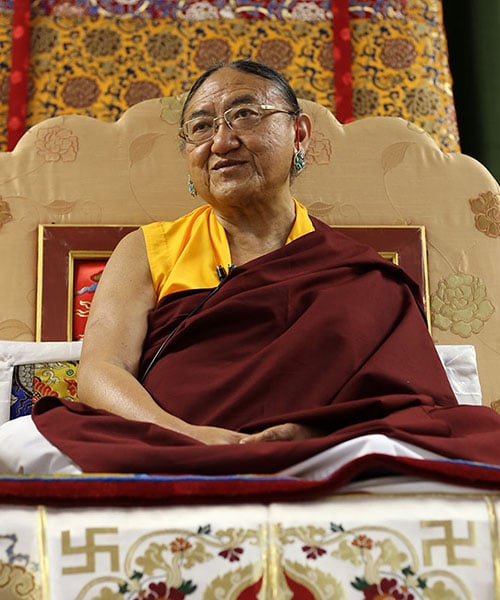 His Holiness the Sakya Trichen. The author received Vajrakilaya empowerment when His Holiness was the 41st Sakya Trizen (Toronto, around 2002 or so. Many years ago, anyway!)
His Holiness the Sakya Trichen. The author received Vajrakilaya empowerment when His Holiness was the 41st Sakya Trizen (Toronto, around 2002 or so. Many years ago, anyway!)
His Holiness Sakya Trichen, (the previous Sakya Trizen) has regularly offered large empowerment events for Vajrakilaya over decades. Vajrakilaya is one of the major Yidams of the Sakaya lineage. Jamyang Khyentse Wangpo, Dilgo Khyentse Rinpoche, Dudjom Rinpoche, and many lamas in the Kagyu and Nyingma lineages are very active in teaching Vajrakilaya.
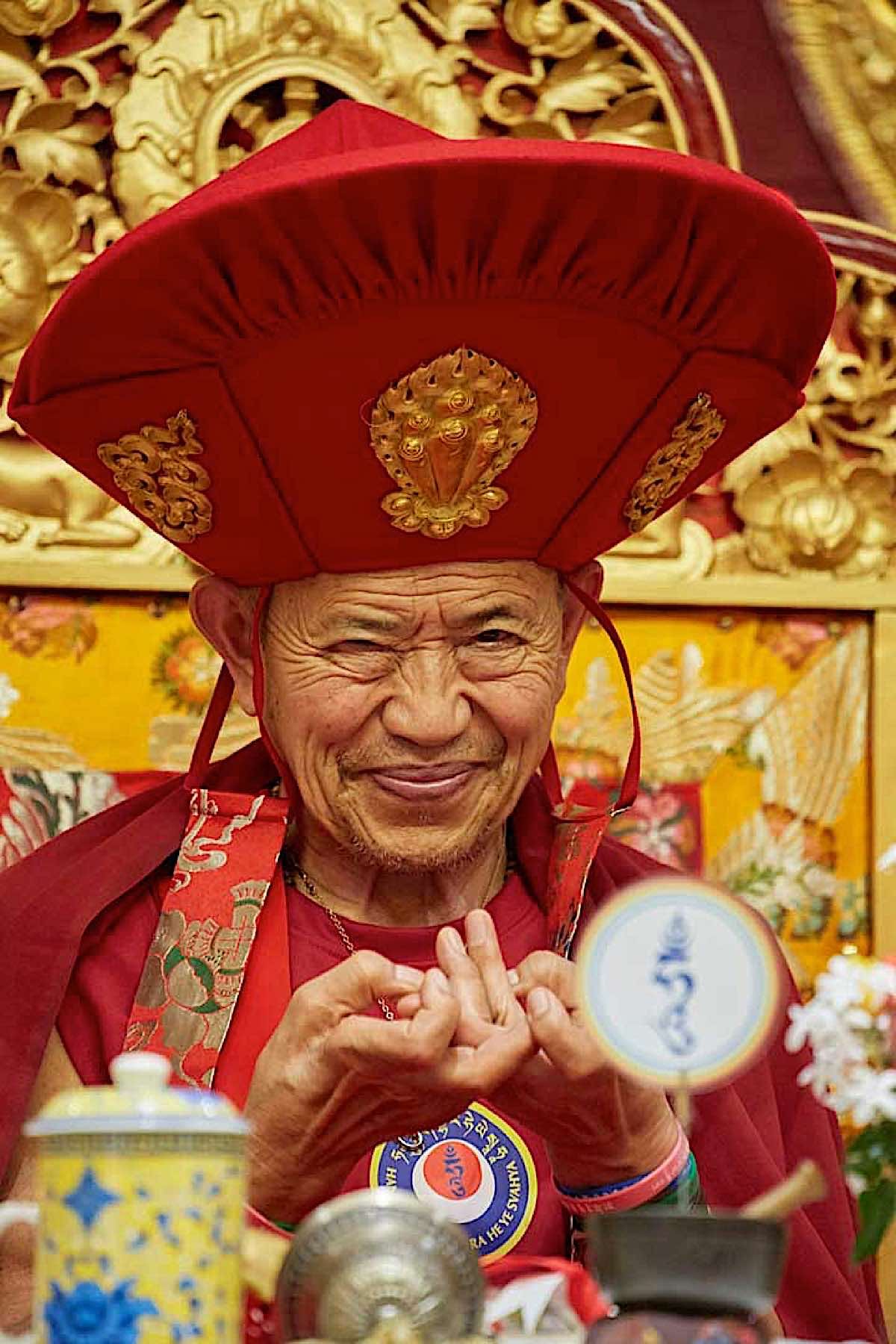 Kyabje Garchen Rinpoche during empowerment.
Kyabje Garchen Rinpoche during empowerment.
One Yidam to rule them all
To misquote a line from Lord of the Rings, most of us need “one Yidam to rule them all.” That isn’t necessarily Vajrakilaya — you and your teacher decide that. But, you normally settle on one, main heart practice, focused on your particular afflictions and obstacles.
There’s a difference between “enlightened deities” and “yidams.” We might practice many Buddhas or enlightened deities regularly — for instance Green Tara, Medicine Buddha, Avalokiteshvara — but most of us only need (or should have) a single Yidam as our heart practice. Garchen Rinpoche again explains this best [5]:
“Although we often use the terms deity and yidam interchangeably, one should understand that the yidam is whichever deity to whom one has committed one’s body, speech, and mind. That is to say, in the practice of deity yoga, one commits or binds (dam) one’s mind (yi) to an ongoing cultivation of the practice. This term for “commitment” is etymologically related to the word samaya (damtsig).”
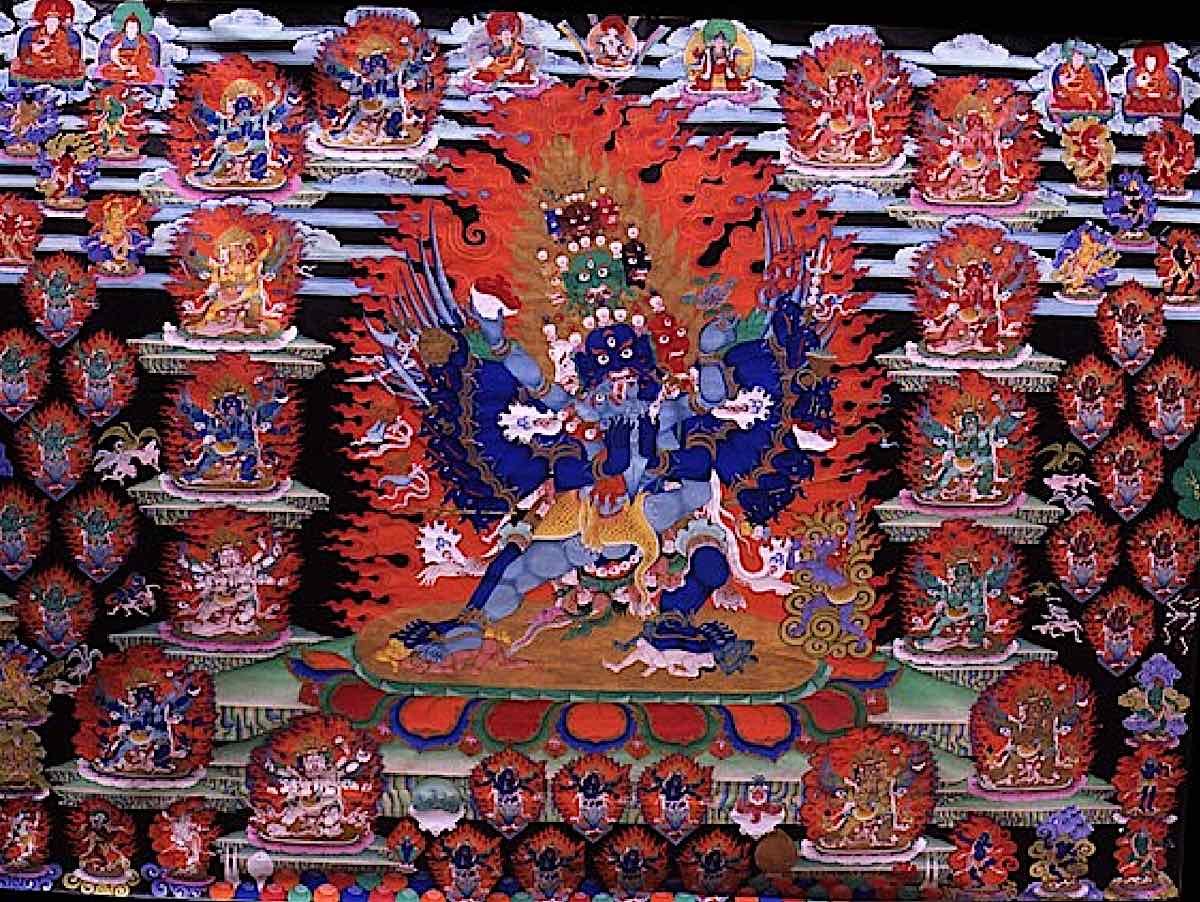 Vajrakilaya Eight Pronouncements. Himalayan Art Project.
Vajrakilaya Eight Pronouncements. Himalayan Art Project.
Other people might find themselves attracted to the Heruka of the magnetizing family, Amitabha’s Heruka emanation Hayagriva [For a feature on Hayagriva, see>>] Still others might find profound realizations from the practices of Green Tara — who also represents all the activities of all the Buddhas, but in a more peaceful form. [For a full section of features on Green Tara, see>>] For people struggling specifically with “anger” and hate issues, they might gravitate to the awesome power of Yamantaka, the Foe Destroyer. [For a feature on Yamantaka, see>>] For those struggling with passions, jealousy and emotion, you might find Vajrayogini. [For a feature on Vajrayogini, see>>]
Ultimately, all Yidams are one essence. Practicing one as a core practice is all that is usually recommended. (Multiple Yidams can be very confusing and distracting and even prevent progress.) Choosing a Yidam based on your afflictions and obstacles, with the help of a qualified lineage guru, is usually best.
Vajrakilaya mantra chanted by Kyabje Garchen Rinpoche:
Kyabje Garchen Rinpoche[6]:
“Although every deity accomplishes all enlightened activities, it is good to consider a deity’s primary activities. Some, like Vajrasattva, mainly display peaceful actions. Others, like Ratnasambhava, manifest enriching activity. According to the scriptures, Vajrakīla is principal among deities who dispel hindrances and obstructive forces. In particular, he is the great antidote to the afflictions of aversion and jealousy, the causes of all the sufferings of this worldly realm.”
But — Yidams are not “ordinary” concrete personalities
Kyabje Garchen Rinpoche goes on to caution [6]:
“It is said in the common development-stage texts that the root of both samsara and nirvana is the mind. If one recognizes the actual condition of the mind just as it is, whichever deity one practices, one will know that deity to be mind itself. The yidam is the guardian and protector of the mind.
When one understands the qualities of the deity’s knowledge, love, and capability, one will know him or her to be a changeless companion. It is through the yidam’s steadfast friendship that one will become able to accomplish all the common and uncommon siddhis from now until the state of Buddhahood is attained. Conversely, even though one may be diligent in deity yoga if this point is not understood, one will end up practicing an independently existent, ordinary deity. This means that one will regard the deity as real and concrete, perceiving the yidam as no different from an ordinary being.”
If you are interested in Vajrakilaya practice, the book by Garchen Rinpoche we’ve been referencing is one of the most informative and helpful in modern terms. [Garchen Rinpoche, Kyabje (2022). Vajrakilaya: A Complete Guide with Experiential Instructions. Translated by Ari Kiev. Shambhala Publications. ISBN 978-1-61180-905-3] It is available on Amazon here (this is an Amazon Associates link, Buddha Weekly may earn a small commission which is used to support our Dharma publications) (or search with the ISBN: https://amzn.to/3bXPhFa
Kyabje Garchen Rinpoche is very active teaching online today. He announced he would limit traveling in the future — but he continues to give empowerment and teachings online. For more visit the Garchen Institute main website>>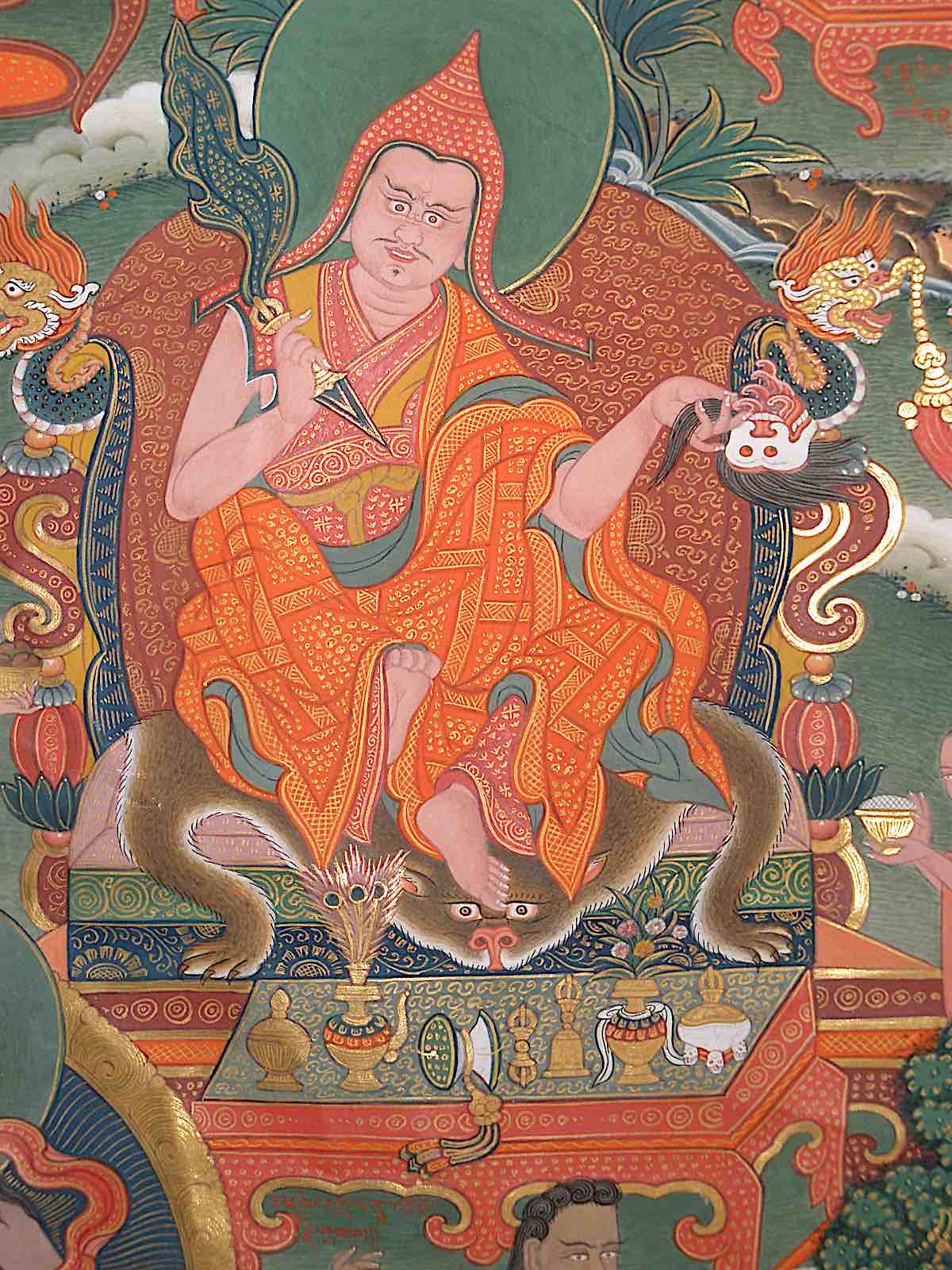 Ralo, Ra Lotsawa, with a Phurba.
Ralo, Ra Lotsawa, with a Phurba.
The sharp weapon — Phurba or Kila
Most iconic of his practice is the symbolic weapon Phurba (Kila in Sanskrit). This is not only part of his name — Vajra Kila literally means Diamond Peg (or knife) — it also represents all of his activities. In most representations and visualizations of this great deity, two of his hands hold a Phurba weapon between them.
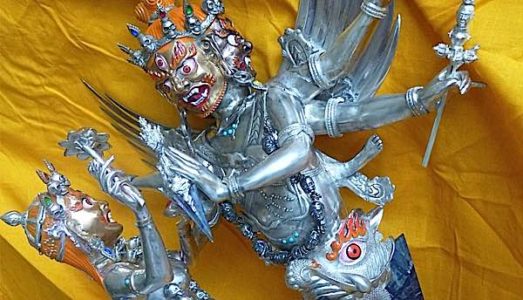 A very special pair of Vajrakilaya with consort Phurba with meteoric metal blades, created by the amazing artisans at Natsog Dorje. See our previous feature on Natsog Dorje and how they are upholding the art/craft of traditional ritual implement making.
A very special pair of Vajrakilaya with consort Phurba with meteoric metal blades, created by the amazing artisans at Natsog Dorje. See our previous feature on Natsog Dorje and how they are upholding the art/craft of traditional ritual implement making.
We call it a “peg” because it has it’s origins as introduced by the glorious Lotus Born Guru Rinpoche from the tent peg. This humble peg, with a three-sided blade, is able to sustain a tent, gompa or shelter against gales when placed correctly. This presents it’s initially metaphorical power of “protection.” In India, the sages would drive pegs around a permit to protect. Later, it became the “sharp weapon” against the three poisons that trap in Samsara, with the three-sided blade representing the ability to cut all three together in one powerful “thrust.” The tent peg became the Vajra Peg, and the symbolism is carried forward in tantric literature.
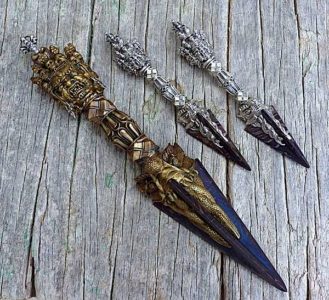 Hand-crafted Phurbas created with meteoric iron blades. Hand crafted at Natsog Dorje.
Hand-crafted Phurbas created with meteoric iron blades. Hand crafted at Natsog Dorje.
The Kila has three prongs, each representing one of the poisons to be cut: hatred/anger (Tib. dosa), attachment/greed (Tib. lobha), and ignorance/delusion (Tib. moha).
The three edges of the Phurba represent:
the Three Worlds (Trailokya or Tiloka, the three planes of existence) united by the “world axis” (handle of the Phurba) (which unites the three worlds) the Three Poisons: each edge represents one of the three: Moha (delusions and confusion), Raga (greed and attachment) and Dvesha (aversion or ill-will) the Three Remedies (Wholesome Qualities) that remedies the three Poisons: Amoha or Prajna (nondelusion or wisdom), Alobha or Dana (non-attachment or generosity) and metta and advesa (loving-kindness and non-hatred) converting the Thee Poisons with the Three Remedies purification of the Body, Speech, and Mind.For more information on Phurbas:
For a full feature on the Phurba on Buddha Weekly, seeThe power of Vajrakilaya’s practice
Vajrakilaya is probably the most wrathful form of all meditational deities, but also one of the most important. In tantric Buddhism, we see that peaceful practices like those of Chenrezig or Tara may not be enough to pacify some circumstances. There are times when much more forceful measures are necessary. This is where Vajrakilaya comes in.
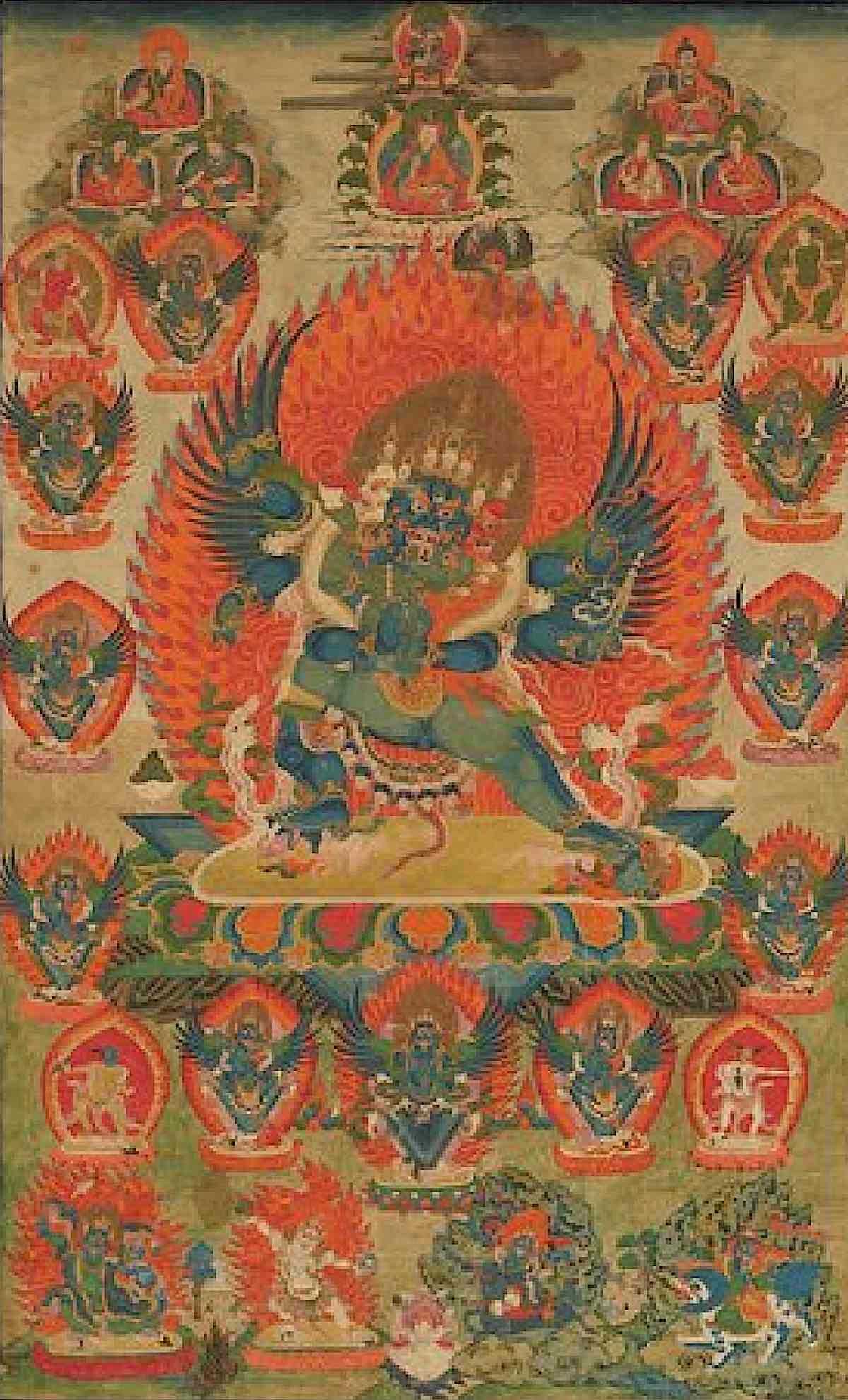 Vajrakilaya. From Himalyan Art project.
Vajrakilaya. From Himalyan Art project.
Vajrakilaya’s practice is particularly efficacious in overcoming obstacles and cutting through negative mental states and conceptual thinking. He is known as the ‘obstacle remover par excellence’, and is one of the most popular meditational deities in the Tibetan Buddhist tradition. There are many different sadhanas, rituals and practices associated with Vajrakilaya, and he is often invoked in times of difficulty or when seeking to overcome obstacles on the spiritual path.
Many of the great masters of Tibet — such as Guru Rinpoche, Milarepa, Longchenpa, Je Tsongkhapa, and Dudjom Rinpoche — have composed texts on the practice of Vajrakilaya.
His practice can be as straightforward as single-pointed concentration and mantra focus, or as elaborate as lengthy multi-day rituals.
An elaborate Vajrakilaya Drupchen:
Vajrakilaya (Skt. Vajrakīlaya; Tib. རྡོ་རྗེ་ཕུར་པ་, Dorje Phurba, Wyl. rdo rje phur pa) or Vajrakumara (Skt. Vajrakumāra; Tib. རྡོ་རྗེ་གཞོན་ནུ་, Dorje Shönnu; Wyl. rdo rje gzhon nu) is the most cutting of wrathful meditational deities.
This aspect of the Buddha is the sharp weapon against the big three enemies: the demons of craving and greed, hate and hostility and ignorance and misapprehension. They flee before his flower and the cutting power of his Phurba. With his Phurba or Kila dagger, he cuts through these obstacles that trap us in Samsara.
The Four Kilas of Vajrakilaya
Central to the practice of Vajrakilaya is the Kila, or Phurba, which forms part of his name. One reason for Vajrakilaya’s enduring popularity is that he — like Green Tara — represents the activity of “all of the Buddhas.” Garchen Rinpoche explains that when you practice and visualize Vajrakilaya, you are practicing all the Buddhas.
In the actual practices, although he is visualized typically holding one Kila or Phurba, there is actually a mandala of Phurbas — one for each of the activities: peace, increase, power and wrath.
Each of these is normally associated with one of the Buddha families (with some variations by lineage):
Power and magnetizing with the Padma family (red) of Amitabha Increase and prosperity/auspiciousness with the Ratna family (yellow or gold) of Ratnasambhava Peace with the Buddha family (white) of Vairochana Wrath with the Vajra family (blue) of Akshobya.In the actual practice, there are often four activity Phurbas corresponding to these activities, although many practitioners just use one activity Phurba. Acitivity Phurbas normally do not have the deity faces on the handle.
For more on Phurbas, see our previous feature>>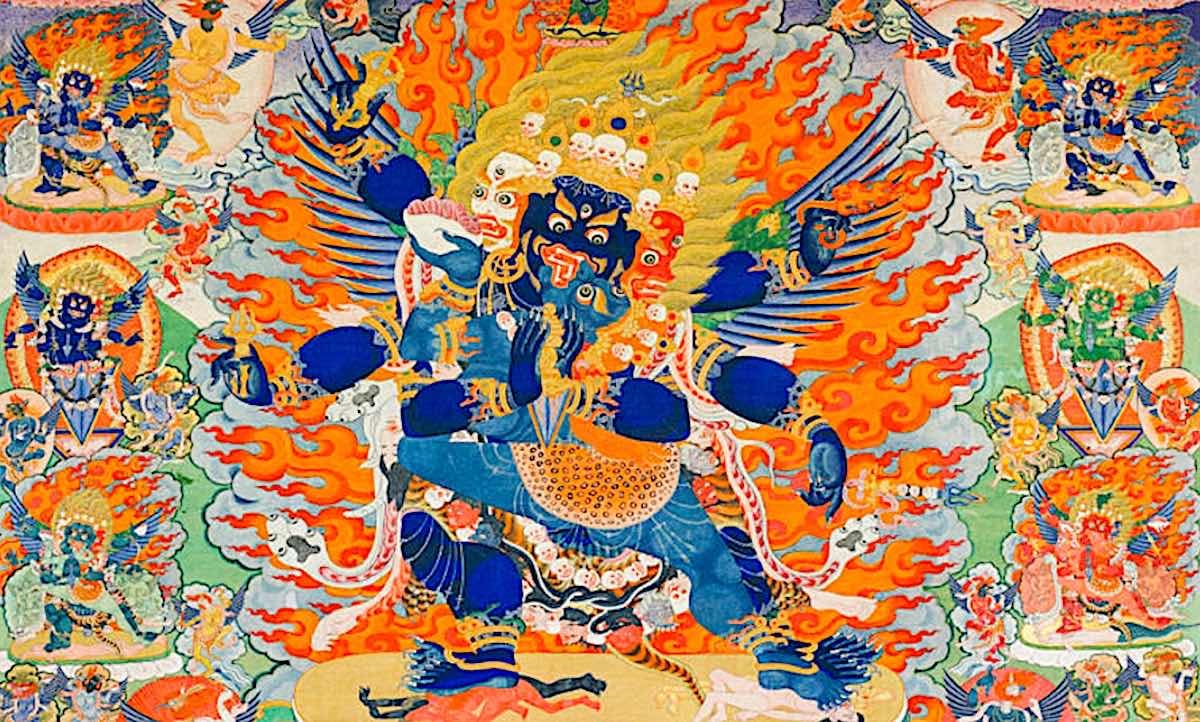 A close-up of Vajrakilaya in his three-face six armed form.
A close-up of Vajrakilaya in his three-face six armed form.
The symbolism of the “Terrible Beauty” of Vajrakumara
The ferocious Heruka Vajrakumara or Vajrakilaya is “terribly beautiful.” His faces are wrathful to demonstrate his power over the most terrible of opponents. Ferocious faces and “large stomachs” are symbols of power — and he has the epitome of both. The large stomach is a symbol of tummo and inner power, and the “demonic” features show he is more powerful than any affliction, demon or poison. At the same time, he is beautiful in his wrath. The third eye on each face demonstrates he is enlightened. His sweeping and grand wings show his heroic power. His deep blue-black color reveals him as a being of ultimate wisdom. The wisdom flames erupting behind him show that his wisdom can overcome all. His dancing pose shows his unflagging power and irresistible force in his Dharma activities on behalf of sentient beings.
 Vajrakilaya close-up. The three faces represent the mind of Enlightenment (blue face), body of Enlightenment (white face) and Speech of Enlightenment (red face), while the consort is the Wisdom consort — since compassion and activity must always be in union with wisdom.
Vajrakilaya close-up. The three faces represent the mind of Enlightenment (blue face), body of Enlightenment (white face) and Speech of Enlightenment (red face), while the consort is the Wisdom consort — since compassion and activity must always be in union with wisdom.
The most common emanation aspect of Vajrakilaya practiced today is the three-faced Heruka aspect with six arms, four legs, and consort.
Most prominently, the lower two hands (left and right) hold the awesome Phurba or Kila dagger. He is adorned with the five bone ornaments and stands in the charnel grounds trampling on his enemies. With him is his wisdom consort Diptachakra. In Vajrayana, the deity and consort represent compassion and wisdom respectively, and are thought of as one being or one combined, an inseparable representation of Enlightenment — the wings of Enlightenment. Compassion without Wisdom and vice versa is not complete.
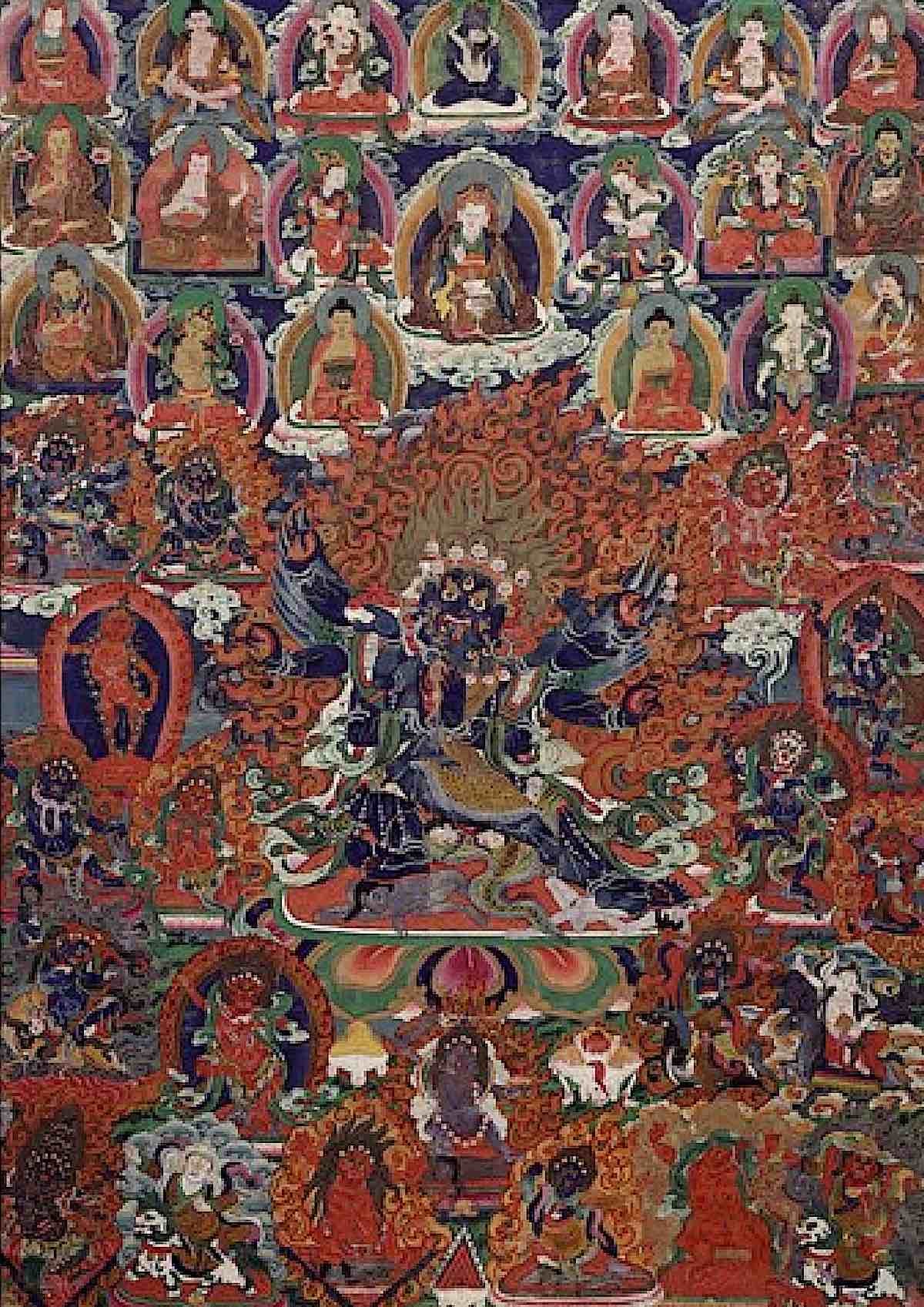 An elaborate thangka of Vajrakilaya and mandala from Himilayan Art Project.
An elaborate thangka of Vajrakilaya and mandala from Himilayan Art Project.
The symbolism may change from lineage to lineage, but the most common would include two vajras in the remaining two right hands (the lower right-hand holds the Phurba clasped with the lower left hand). The top Vajra is normally nine-pronged (representing the nine paths of Buddhism) and the other right hand holds a five-pronged Vajra (representing the five Buddha Families: Amoghasiddhi and consort, Amitabha and consort, Akshobya and consort, Vairochana and consort, and Ratnasambhava and consort). Over his head, we often visualize a Garuda — who is the powerful protector of the “northern” Pureland of Amoghasiddhi, and the head of the Vajrakilaya family is Amoghasiddhi (during the empowerment, it is Amoghasiddhi who manifests above the head of Vajrakilaya.)
In the left hands are a flaming triple wish-fulfilling jewel, called a Triratna in one, plus a trident. The remaining lower left hand clasps the phurba (Kila).
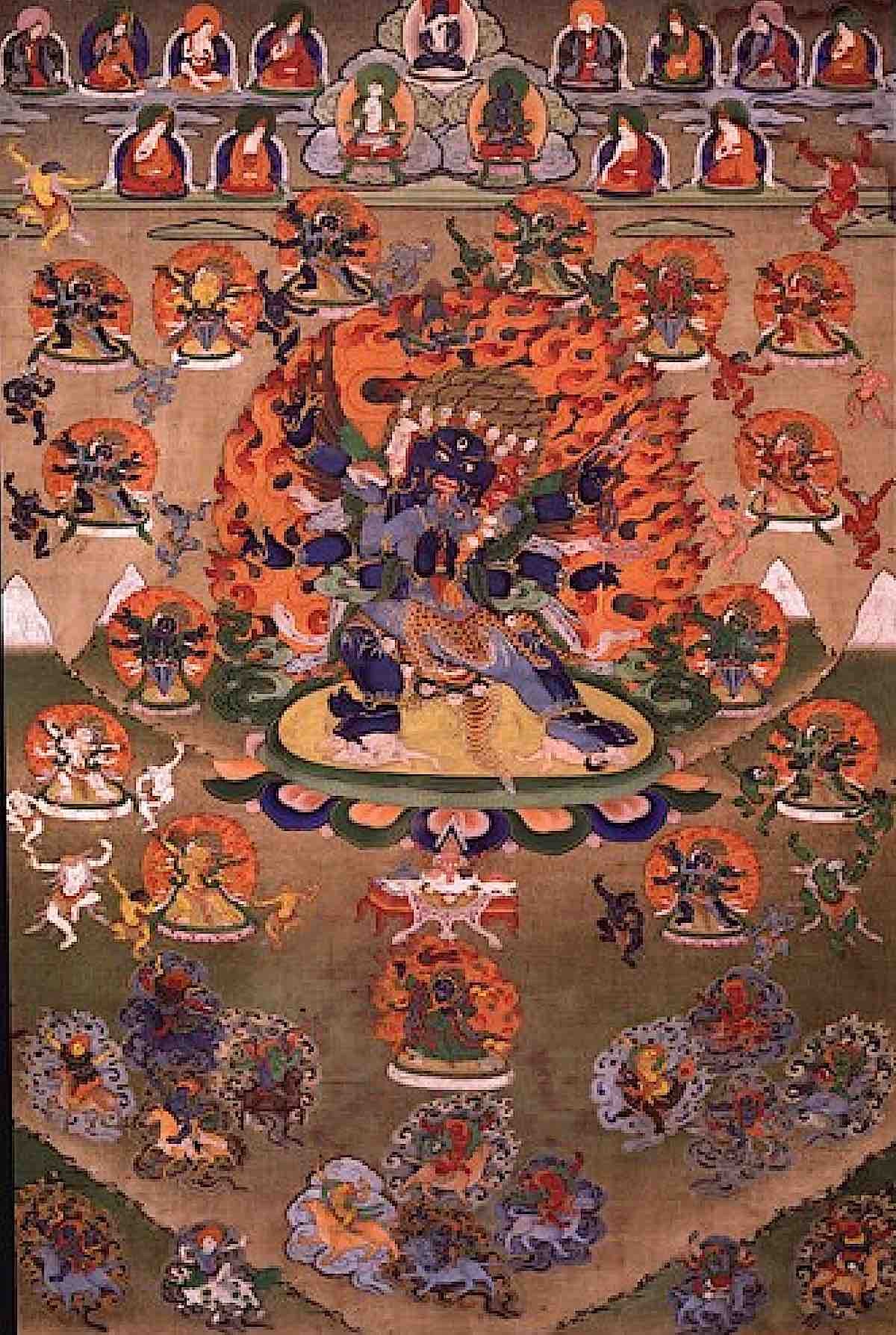 Vajrakilaya Eight Pronouncements from the Himalayan Art collection.
Vajrakilaya Eight Pronouncements from the Himalayan Art collection.
Some “gruesome” imagery
The more gruesome symbols are meant to convey profound concepts and are deliberately representative or wrath and seemingly terrible images. On a rope around his neck are the severed heads — a garland of bija (in Sanskrit Varnamala) — which has very extensive symbolism relating to the fifty Sanskrit syllables, impermanence, and suffering. As is typical of nearly all wrathful ones, he has a tiger-skin loincloth, complete with claws and head. Extensive naga symbols adorn his body as jewelry (naga girdle, hairpiece, ornaments) — showing that he can help us overcome nagas, diseases, and poisons.
Together, he and consort stand on the demons of our affliction, showing that we can suppress them.
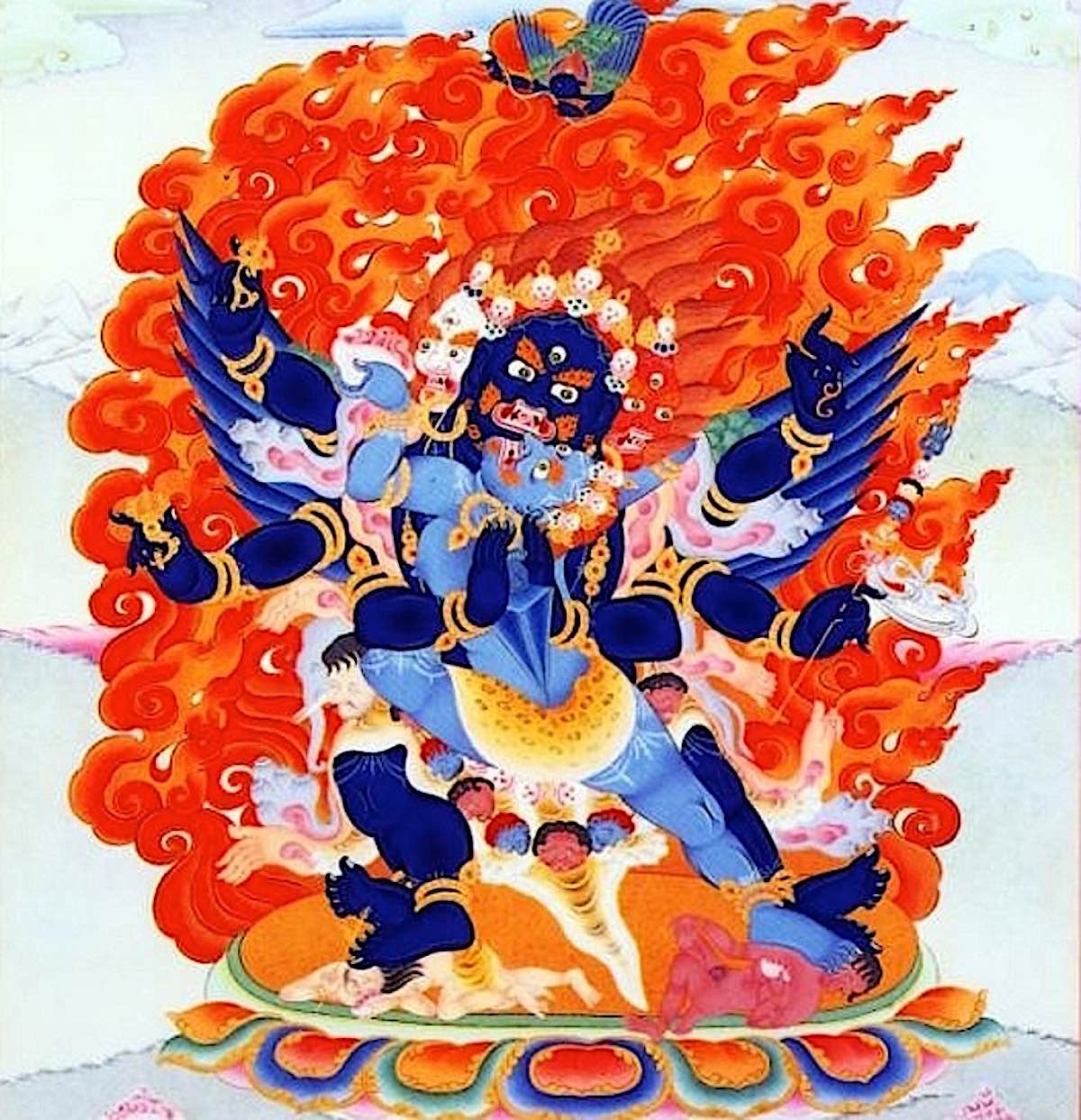 Vajrakilaya.
Vajrakilaya.
Who can practice Vajrakilaya?
Honoring Vajrakilaya with praises, offerings mantras, and prayers can be done by anyone, regardless of their level of spiritual development. However, it is important to receive the proper empowerment from a qualified teacher before attempting any of the Vajrakilaya sadhanas. Generally, the mantras are widely distributed everywhere, but the main prohibition is against self-generation (visualizing the self as the deity) or practicing the Sadhanas. There are often public Vajrakilaya Pujas which anyone can attend.
When we think of Vajrakilaya, it is important to remember that he is not a wrathful deity that we should be afraid of; rather, he is a powerful being who can help us to cut through our own negative mental states and achieve enlightenment.
Many teachers do offer his empowerment and teachings online, including Kyabje Garchen Rinpoche who believes that in this degenerate age Vajrakilaya practice is vitally important.
Vajrakilaya’s Mantra
Garchen Institute and other teachers publish the mantra and mantra videos featuring Garchen Rinpoche. Although the Sadhana (self-generation) is prohibited to anyone not empowered and instructed, the mantra can be a valuable way to bond with Vajrakilaya and help you aspire to find a teacher.

Often due to the characters used in the Tibetan alphabet, Vs in Sanskrit become Bs. In the Vajrasattva mantra, for example, this became Benze Satto or other variations.
In the case of Vajrakilaya’s mantra, the purest English letter transliteration would be
Om Vajrakili Kilaya Sarva Vighnam Vam Hum Phat
In Tibetan this often becomes
Om Benzakili Kilaya Sarva Bighanem Bam Hung Pey
Some people mix the two, as in the example above Om Vajrakili Kilaya Sarva Bighnan Bam Hum Phat.
The Tibetan pronunciation is beautiful chanted by Lama Tenzin Sanpo with Paul Freh: voc, clarinet and Armin Wenger: drum, voc(or the one above in this feature by Gyarchen Rinpoche) in a concert version:
Another very popular version by Lama Tenzin Sangpo (same chanter, but not a live concert) is:
What about this secret mantra?
This is often misunderstood, with people in forums talking about Vajra hells and so on for revealing secret mantras. That isn’t a modern approach to understanding Tantra, however. Secret doesn’t mean some secret punishable by X,Y or Z.
Kyabje Garchen Rinpoche explains more fully [11]:
“The quick path—the Secret Mantric Vajra Vehicle—is referred to as secret not because it is something to be concealed or covered up but because its meaning cannot be fathomed. This is the case for ordinary beings of the six classes, who experience the sufferings of the three lower realms due to the afflictions of the three poisons. This is like when water, which is inherently crystal clear, accidentally becomes tainted by impure substances. However, when the water is purified and returned to its natural state, it is suitable for drinking and bathing. Similarly, the fundamental buddha nature is pure at the very basis.
This quality of the mind is referred to in the dzogchen tradition as “pure from the beginning.” In the context of mahāmudrā, it is called “primordial purity.” These two terms have the same meaning. Whenever the afflictive poisons meet with bodhicitta, they are transformed into the five wisdoms, just as wood changes into flame when fuel meets with fire. In this way, sentient ones can transform into buddhas. The fact that suffering beings can attain the status of the buddhas is not something that needs to be kept hidden; it simply is not readily understandable.”
In other words we need a teacher and profound practice to understand the secret — but this is not a secret punishable by “Vajra” hells and other “spiritual” scare tactics.
Having written that, although it’s fine to praise and honor Vajrakilaya, and likely even aspirationally helpful to chant his mantra, self-generation and the Sadhanas require instruction to practice.
NOTES
[1] Beer, Robert (1999). The Encyclopedia of Tibetan Symbols and Motifs. Shambhala. ISBN 978-1-57062-416-2.
[2] Garchen Rinpoche, K. (2022). Vajrakilaya: A Complete Guide with Experiential Instructions. Translated by Ari Kiev. Shambhala Publications. ISBN 978-1-61180-905-3
[3] Garchen Rinpoche, Kyabje. Vajrakilaya (pp. 5-6). Shambhala. Kindle Edition.
[4] Garchen Rinpoche, Kyabje. Vajrakilaya (pp. 7-8). Shambhala. Kindle Edition.
[5] Garchen Rinpoche, Kyabje. Vajrakilaya (p. 8). Shambhala. Kindle Edition.
[6] Garchen Rinpoche, Kyabje. Vajrakilaya (p. 10). Shambhala. Kindle Edition.
[7] Garchen Rinpoche, Kyabje. Vajrakilaya (p. 11). Shambhala. Kindle Edition.
[8] “Lam rim teachings at Sera Jey” Dalailama.com site>> https://www.dalailama.com/news/2013/third-day-of-lam-rim-teachings-at-sera-jey
[9] Garchen Rinpoche, Kyabje. Vajrakilaya (pp. 20-21). Shambhala. Kindle Edition.
[10] Garchen Rinpoche, Kyabje. Vajrakilaya (p. 20). Shambhala. Kindle Edition.
[11] Garchen Rinpoche, Kyabje. Vajrakilaya (pp. 39-40). Shambhala. Kindle Edition.

 Tekef
Tekef 
































